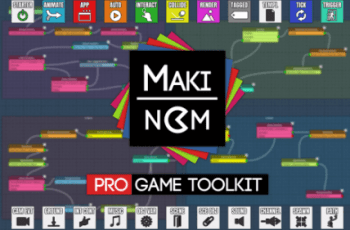This is a paid asset, but now you can download Makinom 2 Pro: Game Toolkit for FREE, but please remember this package is provided only for learning purposes or to be able to test before buying the product, NOT FOR COMMERCIAL PURPOSES.
Detail this asset from Unity Store: Original Link
Makinom 2 Pro: Game Toolkit v2.2.0
Makinom is a powerful and flexible general-purpose toolkit for Unity, allowing you to create game controls, game mechanics or interactions with your game world without writing a single line of code.
Create all kinds of 2D or 3D game genres: Roguelikes, platformers, shooters, action-adventures, 1st- or 3rd-person, and many more!
Website | Demos | Documentation & Tutorials | Support | Unity Forum
Schematics
Create reusable, node-based blueprints of what you want to do. Schematics work similar to flow charts, each node performs a task and decides the next node that’ll be executed. There are over 400 nodes available, ranging from simple things like playing an audio clip, spawning a prefab or increasing a counter to complex operations like moving/rotating over time or fading to a new camera position.
Schematics are used to create player/camera controls, game mechanics, dialogues and other interactions, cut-scenes, AI and handle animations, movement and many other things.
Machines
Machine components are used to play your schematics (but schematics can also play other schematics). There’s a machine for every use case, e.g. Tick Machines handle update-based functionality like player/camera controls, Trigger Machines can start when an object enters an area or Collision Machines when a bullet hits a target.
Tagged Machines are used to create a uniform setup for your game mechanics, e.g. starting whatever happens when something is killed or destroyed via the same tag (e.g. ‘kill’), for items and other pickups this can trigger collection, while on enemies it’ll play their death animation and drop loot or increase the score.
Often used machines can be set up as templates for easy reusability.
Languages
The best approach to localization during development is to not worry about it. Define the content in your native/preferred language and use Makinom’s language export/import functionality to easily add additional languages at a later time. You can also add notes to the translators when defining your content, e.g. to emphasize the context or let them know not to translate a name or word.
Modular UI
Build HUDs, dialogues, menus and flying texts (e.g. damage numbers). HUDs can also be used for virtual controls.
The UI system is modular and completely separated from the rest, allowing you to switch it out if needed. Makinom currently comes with the Unity UI module (requires Unity UI and TextMeshPro) and will support UI Elements in the future (when it’s available for in-game use).
Other Features
Input system (extensible, support for local multiplayer and control styles)
Save game system (and custom save data support)
Game states (automatic and manual state changes and as conditions for machines)
Variables (with different scopes: global, object-bound and local, e.g. in running schematics)
Audio and music management
Game object pooling
Formula system (node-based)
Built-in documentation for each setting
Paths and waypoints
Supports Mecanim, legacy animation and custom animation systems
Grid feature (e.g. for match 3 gameplay or level architecture)
And more …
Pro Version
Makinom Pro contains the full C# source code.
Get Makinom Free if you don’t need that or want to try it out first, it’s free and the complete package!
Compatibility
Makinom supports publishing to Windows, Mac OSX, iOS and Android.
Makinom requires Unity 2019 or newer, using the Unity UI module requires Unity UI and TextMesh Pro.
Upgrade from Makinom 1
Looking to upgrade your Makinom 1 project to Makinom 2?
Check out the Makinom Upgrade Tool!
Using the Unity UI module requires having the Unity UI and TextMesh Pro packages imported in your project.
Unity Compatibility
Requires at least Unity 2019.4, using LTS versions is recommended.
Please note that new Unity releases might be incompatible until an update has been released.

